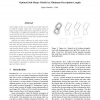Free Online Productivity Tools
i2Speak
i2Symbol
i2OCR
iTex2Img
iWeb2Print
iWeb2Shot
i2Type
iPdf2Split
iPdf2Merge
i2Bopomofo
i2Arabic
i2Style
i2Image
i2PDF
iLatex2Rtf
Sci2ools
CVPR
2005
IEEE
2005
IEEE
Optimal Sub-Shape Models by Minimum Description Length
Active shape models are a powerful and widely used tool to interpret complex image data. By building models of shape variation they enable search algorithms to use a priori knowledge in an efficient and gainful way. However, due to the linearity of PCA, non-linearities like rotations or independently moving subparts in the data can deteriorate the resulting model considerably. Although non-linear extensions of active shape models have been proposed and application specific solutions have been used, they still need a certain amount of user interaction during model building. In this paper the task of building/choosing optimal models is tackled in a more generic information theoretic fashion. In particular, we propose an algorithm based on the minimum description length principle to find an optimal subdivision of the data into subparts, each adequate for linear modeling. This results in an over all more compact model configuration. Which in turn leads to a better model in terms of modes ...
Active Shape Models | Compact Model Configuration | Complex Image Data | Computer Vision | CVPR 2005 | Optimal Models | Shape Variation |
| Added | 12 Oct 2009 |
| Updated | 12 Oct 2009 |
| Type | Conference |
| Year | 2005 |
| Where | CVPR |
| Authors | Georg Langs, Philipp Peloschek, Horst Bischof |
Comments (0)

